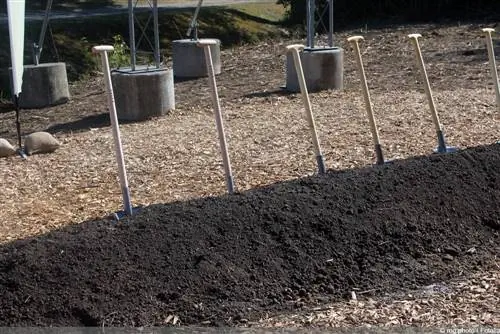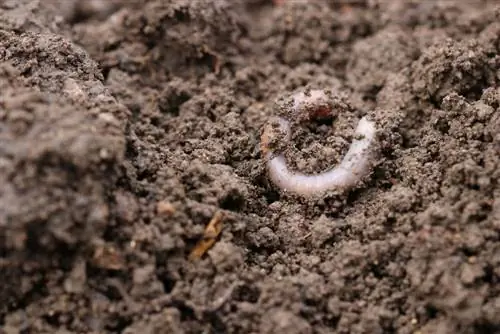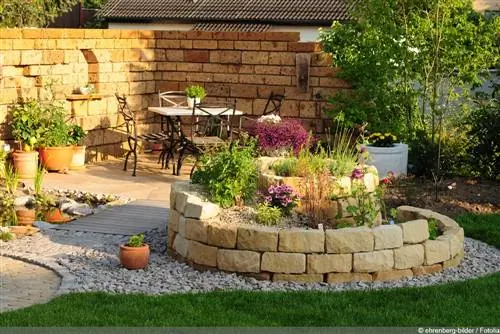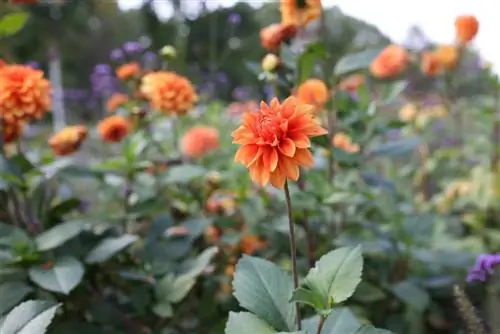- Author admin [email protected].
- Public 2023-12-17 03:39.
- Last modified 2025-01-24 12:45.
The flat surface is of course ideal for gardens and properties. However, sometimes local conditions are such that differences in height have to be compensated for. Then you usually can't avoid an earth wall or an embankment. And the fastening and planting are crucial factors here. Here are a few little tips that can help you do everything right.
Building permit
In order to be able to build an earth wall, a building permit is often required. However, the requirements differ from state to state. In principle, an embankment or embankment is also a structural system that can, under certain circumstances, have a similar effect to a building. The decisive factor for the evaluation is the size and especially the height of the system. In this context, it is also important that the prescribed distances to neighboring properties must be adhered to. The application for a building permit must be submitted to the responsible municipality or city. The approval authority is always the building authority. The application must usually be accompanied by a plan which shows in detail the shape and dimensions of the embankment.
Tip:
It's best to ask your local or city administration in advance whether a building permit is necessary and what documents need to be provided.
Soil
If you want or need to create an embankment, you need the right material - and lots of it. Conventional soil is completely sufficient for this. You either take it from your own property or have it delivered to you by a company that specializes in it. The amount required obviously depends on the size of the planned slope. An extremely important factor in this context is the inclination. In principle, it should not exceed an angle of 45 degrees, otherwise the risk of landslides becomes too great. The following applies: the flatter the angle of inclination, the more space is required for the slope. Conversely, this also means that a larger amount of soil is necessary. Exact information on the quantity is naturally difficult as it depends on the local conditions.
Stratification and investment
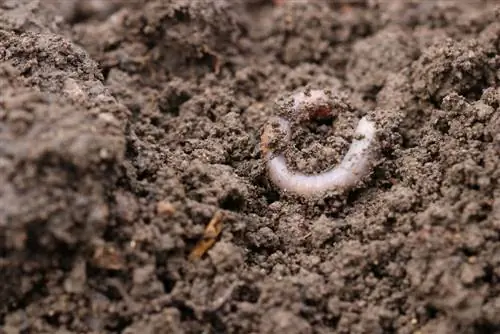
Essentially, creating a slope involves filling up soil. This can be done either with a wheelbarrow and shovel or with an excavator. For larger objects, you will hardly be able to avoid using heavy equipment, otherwise the effort would usually be beyond the capabilities of laypeople. It is best to choose coarse stones as the basis for the embankment. Conventional soil is placed on top. Finally, a layer of humus is recommended, as the slope is usually intended for planting. The system therefore consists of three layers, of which the central layer of earth is by far the largest. After filling, it is important to first let the soil sink in and then, ideally, to tamp it down with a vibrator to avoid unintentional soil loss.
Embankment mats
In the area of the upper surface layer of the slope, so-called embankment mats can be a first step towards stabilizing the slope. This is a fabric made of coconut that is simply placed on the ground and secured with wooden pegs. The rule of thumb is: the tighter the fabric, the better the fastening effect. The aim is to consolidate the soil as well as possible in the area of the steep surface in order to secure it until the shrubs and grasses that will be planted later can take root. The coconut mats rot over time by themselves and do not need to be removed separately. They are available in different sizes and designs from garden retailers and hardware stores.
Fixing measures
Every slope must be secured to prevent slipping in the long term. In any case, appropriate fastening is required at the foot of the steep surface. In some circumstances it may also be necessary to attach the sides. All fastening measures have a supporting function. Walls of all types are best suited for this - from the mortared stone wall to the dry stone wall. Under certain circumstances it may be necessary to lay a foundation for the wall. It is also important to install drainage to drain water in the area between the base of the slope and the wall. If building a foundation is too complicated for you, you can also use a wooden palisade. This consists of individual wooden stakes that are rammed into the ground in a row.
Planting
Planting an earth bank doesn't just make sense for visual reasons. What is even more important is that the roots of the plants hold the soil together and in this way stabilize it. The plants also serve to ensure the safety of the entire system. The first thing that comes to mind in this context is usually grass. No wonder: a green hill appears simple, but also very natural. However, you should keep in mind that the grass needs to be mowed regularly. However, mowing on an incline can be a major challenge. This can hardly be done with a conventional lawn mower. An alternative is to use a scythe, which is of course much more complex and requires a lot of practice. A type of lawn on a slope is usually only recommended if the angle of inclination is relatively small.
Plant species

It is much easier to plant shrubs and ground-covering perennials than planting grasses. On the one hand, this combination looks great and, on the other hand, reliably ensures that the sloping ground has more support. Once the roots of the plants are firmly anchored in the ground, they form a relatively dense network with their countless extensions that, to a certain extent, hold the earth in place. The following plant species have proven to be particularly suitable:
- Lady's Mantle (Alchemilla mollis)
- Golden nettle (Lamium galeobdolon)
- Storksbill (Geranium)
- Fairy Flower (Epimedium)
- Waldsteinia (Waldsteinia ternata)
- Carpet St. John's wort (Hypericum calycinum)
- Ivy (Hedera helix)
- Ysander (Pachysandra)
The carpet St. John's wort, ivy and ysander have the great advantage that they do not lose their leaves even in winter and thus provide additional protection from above even when there is a thick blanket of snow. All plant species mentioned are also very easy to care for and robust. They are also relatively undemanding and of course hardy. When selecting plants, it is important to consider which location they prefer. Since earth walls are very often exposed to direct sunlight, only plants that require a sunny location may be used.
Planting plants
A slope is generally planted as densely as possible from top to bottom. However, it should be noted that certain distances must be maintained. The best way to find out how big these need to be is to contact the nursery or specialist retailer where you buy them. If you have previously planted embankment mats, a hole or slit must be cut in the mat for the planting hole, otherwise the roots would not be able to penetrate it. Of course, it takes some time until the plants are really firmly rooted in the soil. It is therefore recommended to provide the soil with a layer of bark mulch in the first few weeks and months. On the one hand, this protects the soil from undesirable erosion. On the other hand, it also prevents the excessive growth of weeds that compete with perennials and shrubs.
Water drainage
Hardly any plant can cope with waterlogging. The drainage of water is therefore particularly important in an earth wall. Trenches on the sides of the wall filled with pebbles can provide valuable support. In general, natural stones in different sizes are perfect for embankments. If placed correctly, they not only protect individual plants from falling water, but also stabilize the soil to a certain extent.

